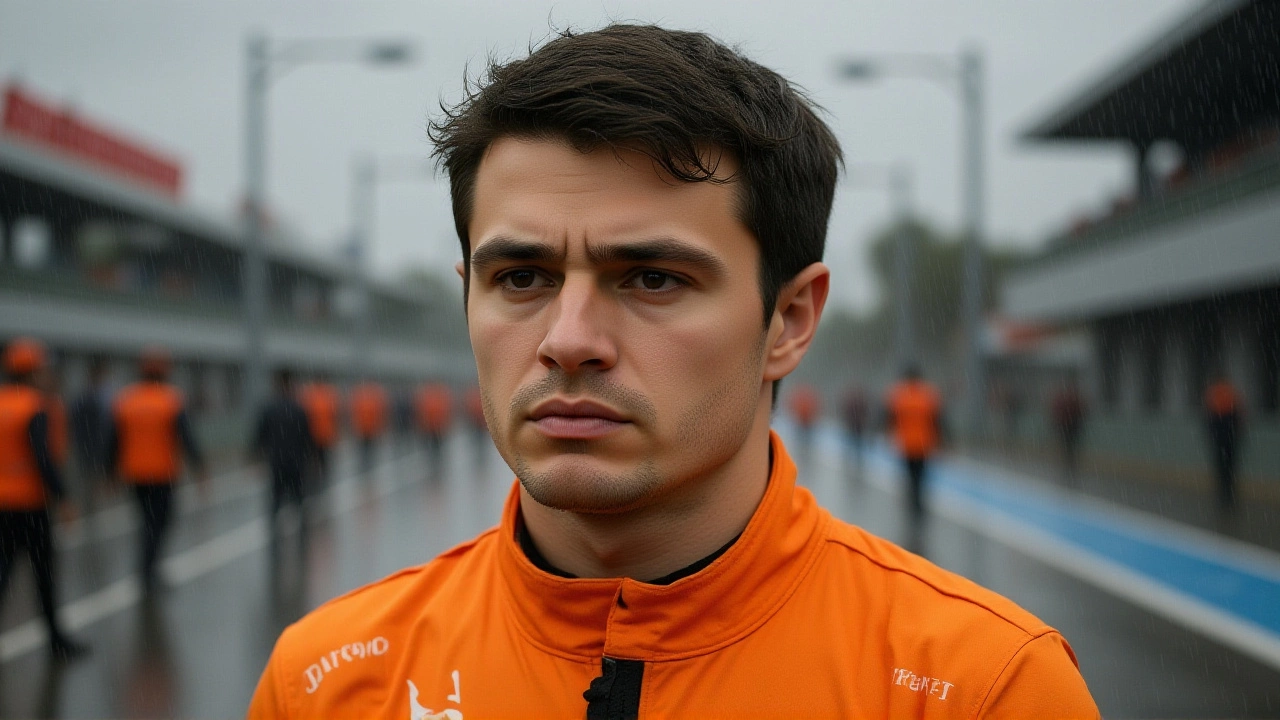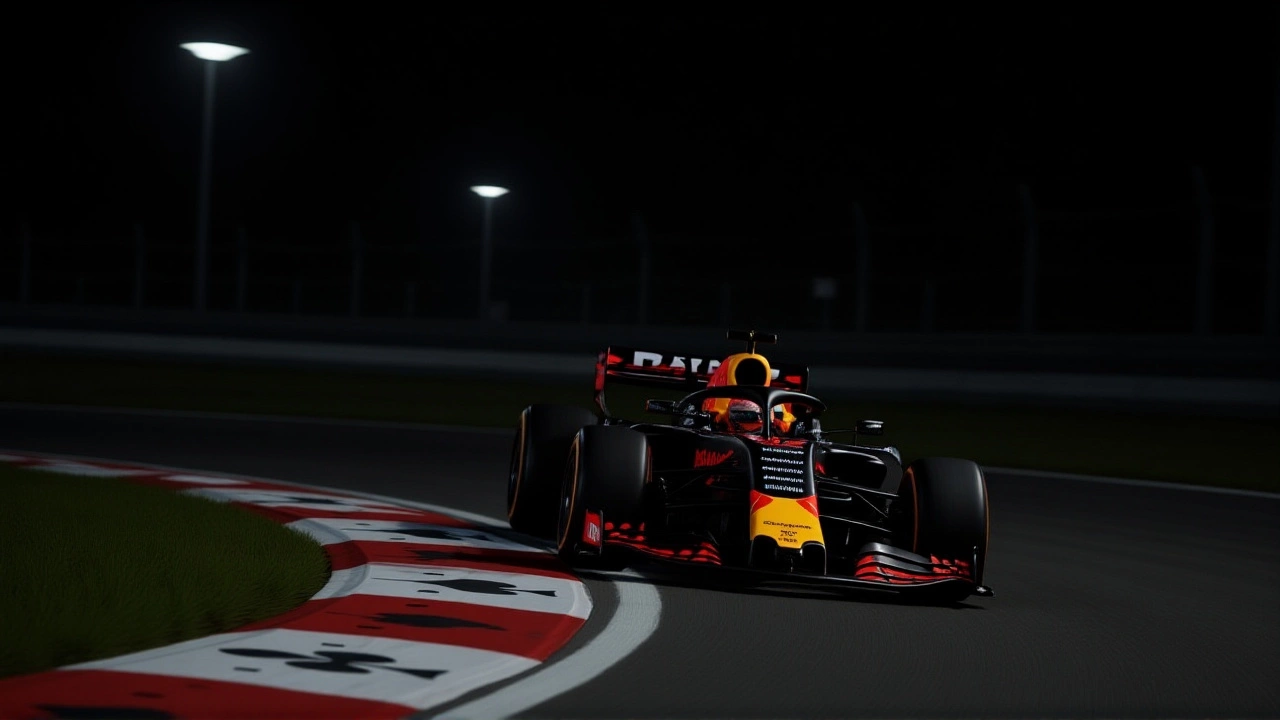Lando Norris Claims Historic Wet Pole at 2025 Las Vegas Grand Prix
 Nov, 23 2025
Nov, 23 2025
When the rain started falling over the Las Vegas Strip on Saturday night, no one expected it to rewrite history — but Lando Norris did just that. The 25-year-old British driver snatched pole position in the first-ever wet qualifying session at the Las Vegas Strip Circuit, clocking a blistering 1:47.934 in the final moments of Q3. The session, held on November 22, 2025, turned the usually glitzy, dry desert track into a treacherous water slide — and Norris, cool as ever, turned chaos into control.
It wasn’t supposed to be this way. Las Vegas in November is supposed to be clear skies and high-pressure calm. But a rare weather front rolled in, turning the 6.120-kilometer street circuit into a gamble. Drivers slid, locked up, and clipped barriers. Lewis Hamilton, last year’s runner-up, never even made it to the checkered flag on his final lap — missing it by half a second, according to ESPN F1. Meanwhile, Alex Albon of Williams Racing smashed into the Turn 14 barrier with 30 seconds left, ending his hopes. Even Carlos Sainz, who briefly held provisional pole, was flagged for an unsafe rejoin after leaving the track.
The McLaren Showdown
The real drama unfolded inside McLaren’s garage. Norris and his teammate Oscar Piastri were locked in a tense battle for supremacy. Piastri, just 0.4 seconds slower, scraped into the top 10 by the slimmest of margins — a result that turned the final shootout into an all-McLaren duel. "It’s a McLaren shootout," noted Cockatoo’s live commentary, capturing the moment when Piastri’s final lap looked like it might steal the crown. But Norris, already fastest in Sector 1, held firm. "He’s got two cars ahead provisionally," the commentator said, referring to Verstappen and Sainz. "But Norris is four tenths up on Piastri. That’s the gap that matters."
That gap wasn’t just about speed — it was about nerve. While others panicked in the spray, Norris stayed smooth, reading the track like a map. He didn’t push too hard in the middle sector, saving tires and grip for the final corner. "He’s not trying to win qualifying," said one insider. "He’s trying not to lose it."
Red Bull’s Quiet Strategy
Meanwhile, Red Bull Racing played the long game. Max Verstappen qualified fourth — not because he was slow, but because he was conserving tires for Sunday. Pre-race technical analysis from Formula 1’s "TECH TALK" series revealed both Red Bull and McLaren had clipped their front wings by 15mm to reduce drag on the long straights of the Las Vegas Strip. The move was risky — less downforce means less grip in the wet — but it paid off. Verstappen’s car, lighter on the front end, could carry more speed through the high-speed sweepers.
George Russell, meanwhile, got a crucial tow from Pierre Gasly on his final lap, lifting him into second place on the grid. "It was a hand-off," Russell admitted post-session. "Pierre didn’t have to do that. But he did. That’s racing."

The Race That Followed
By Sunday afternoon, the rain had vanished. The track dried quickly under Nevada’s sun, and the real battle began. Norris, starting from pole, held his lead off the line — until Turn 3. A momentary lock-up sent him wide, and Verstappen, who’d been lurking in the mirrors, pounced. "Verstappen seizes lead as Norris runs wide in dramatic start," read the official race highlights caption, released just hours after the checkered flag.
Verstappen, driving the #1 Red Bull, never looked back. He won by 3.2 seconds over Russell, whose Mercedes-AMG Petronas Formula One Team delivered a flawless race. Third place went to 19-year-old Kimi Antonelli of Scuderia Ferrari, whose podium finish marked the youngest podium by an Italian since 1950. Sainz, who had qualified sixth after his earlier penalty, finished seventh — a bitter outcome after his brief pole stint.
Why This Matters
This wasn’t just another race. It was the first time in the 75-year history of Formula 1 that a wet qualifying session at a street circuit in a desert climate produced a pole-sitter who didn’t win the race. It highlighted how unpredictable Las Vegas has become — a track where weather, not just engineering, decides outcomes. The fact that Norris, the championship leader, could still take pole under such conditions speaks volumes about his growing mastery.
Williams Racing, meanwhile, ended their 11-year pole drought in the qualifying session — even if only for a few seconds. Albon’s crash, though costly, was a reminder of how thin the margin is. And Hamilton’s failure to make the final lap? A sobering sign that even legends can be outpaced by conditions.

What’s Next?
With the championship now heading into its final three races, Norris leads by 18 points — but Verstappen’s win in Vegas has reignited the title fight. Teams are already analyzing data from the wet session: how tire compounds held up, how aerodynamic tweaks performed under spray, and whether the wing adjustments should be permanent. The FIA is also reviewing the safety protocols for future street circuits in unpredictable climates.
Next stop: Abu Dhabi. Dry. Fast. Cold. And if history holds, it’ll be the most decisive race of the season.
Frequently Asked Questions
How rare is a wet qualifying session in Las Vegas?
Extremely rare. The Las Vegas Grand Prix debuted in 2024, and the 2025 session was the first time rain affected qualifying since the event began. November in Nevada averages less than 0.2 inches of rainfall, making this a once-in-a-decade weather anomaly. The last time Formula 1 saw a wet qualifying on a street circuit was in Monaco in 2021.
Why did Norris’s pole position not lead to a win?
Because qualifying and racing are different beasts. Norris’s wet-weather pace was unmatched, but on a dry track, Verstappen’s Red Bull had superior straight-line speed and tire management. A single mistake at Turn 3 — a lock-up that sent Norris wide — gave Verstappen the opening he needed. Pole position doesn’t guarantee victory, especially on street circuits where overtaking is rare but mistakes are costly.
What technical changes did McLaren and Red Bull make for Las Vegas?
Both teams reduced front wing angle by 15mm to cut drag on the long straights of the Las Vegas Strip. This improved top speed by 2-3 km/h but reduced downforce, making the cars more sensitive in corners — especially in wet conditions. The trade-off paid off in the race, where straight-line speed mattered more than cornering grip.
How did George Russell get such a strong qualifying result?
Russell benefited from a strategic slipstream from Pierre Gasly on his final lap. Gasly, who was already out of contention, deliberately held a line that allowed Russell to draft behind him, gaining up to 0.2 seconds on the main straight. This is legal under F1 rules and is often used by teammates or allied teams to boost lap times — a subtle but critical tactic in tight qualifying battles.
What does Kimi Antonelli’s podium mean for Ferrari?
It’s a major milestone. At 19, Antonelli became the youngest Italian on the F1 podium since 1950 and the first rookie to stand on the podium in Las Vegas. His performance signaled Ferrari’s return to competitiveness after a rough mid-season. With Carlos Sainz struggling and Charles Leclerc out of the title hunt, Antonelli’s rise suggests Ferrari’s future is brighter than their 2025 standings suggest.
Will wet qualifying become a regular feature in Las Vegas?
Unlikely — but not impossible. Las Vegas’s desert climate makes rain rare, but climate change is increasing weather volatility. F1 organizers are now considering contingency plans for wet conditions, including extended qualifying windows or modified tire allocation rules. For now, this remains a historic anomaly — but one that may change how teams prepare for future street races.